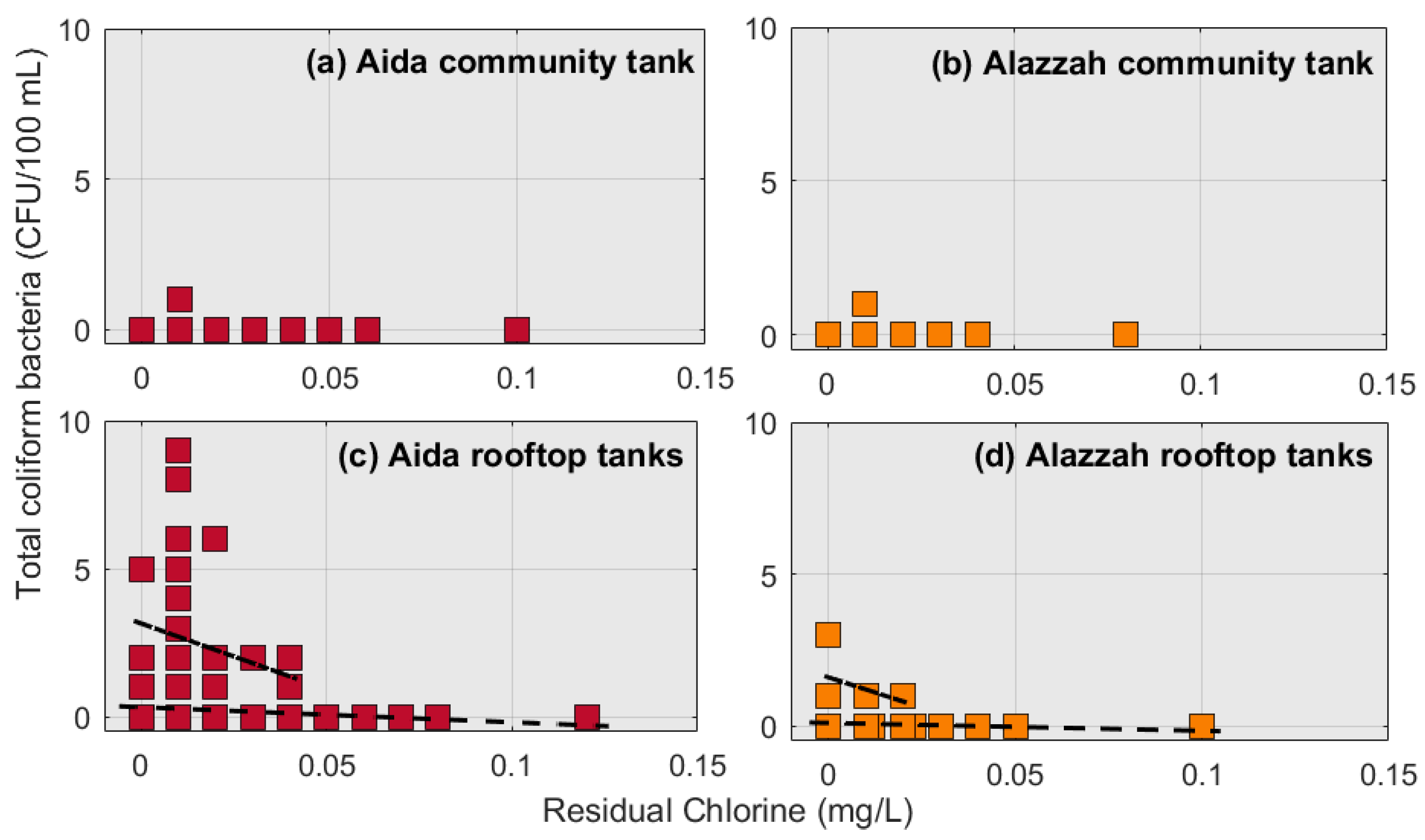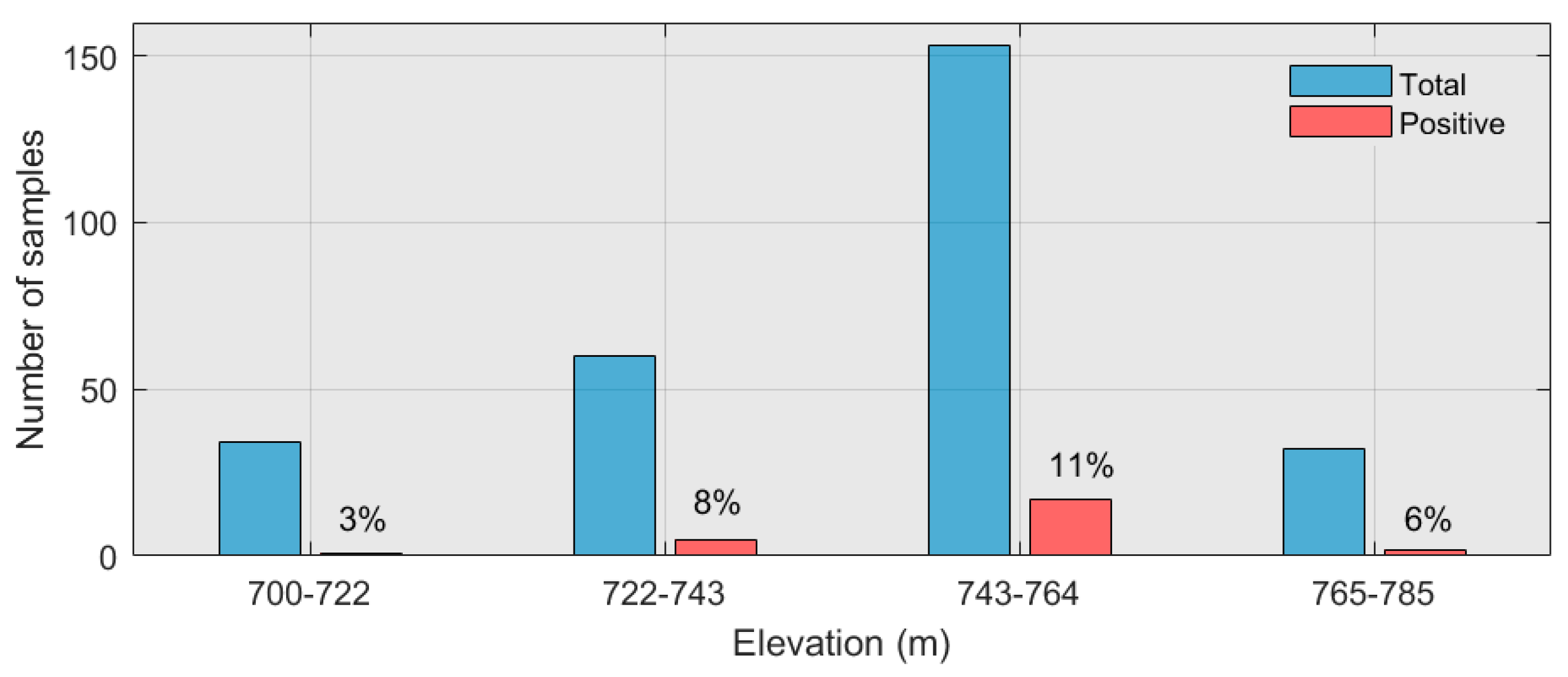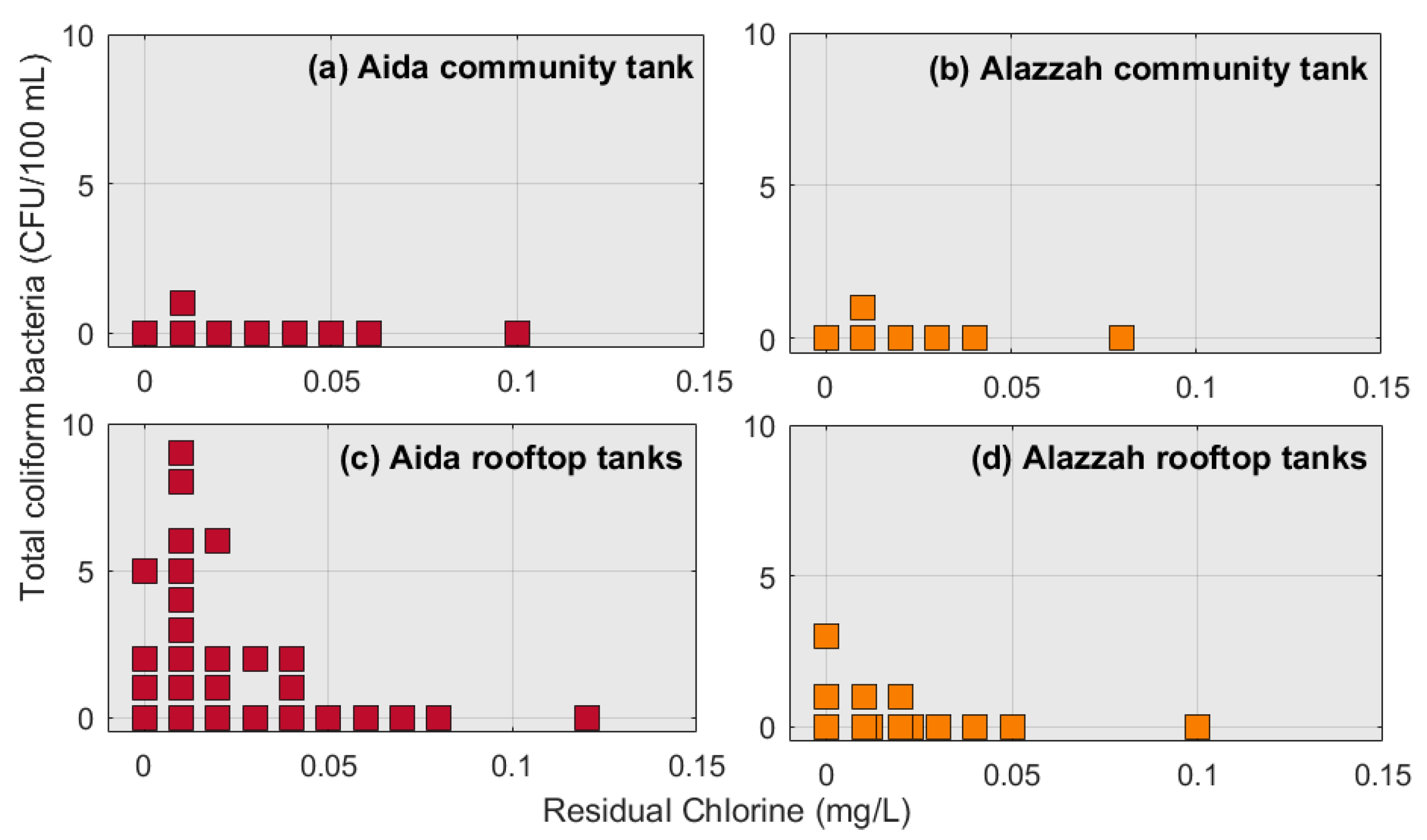Impacts of Intermittent Water Supply on Water Quality in Two Palestinian Refugee Camps
Abstract
:1. Introduction
2. Materials and Methods
2.1. Study Areas
2.2. Water Sample Collection
2.3. Bacteria Testing
2.4. Residual Chlorine Testing
3. Results
3.1. Bacterial Testing Results
3.2. Factors Affecting Bacterial Testing Results
4. Discussion
Author Contributions
Funding
Acknowledgments
Conflicts of Interest
Appendix A


| Camp | CFU Data | Co-Variate | Linear Model | SSE | R2 | Adj-R2 | RMSE |
|---|---|---|---|---|---|---|---|
| Aida | All | Res.-Cl | m = −5.093 (−11.17, 0.9886); b = 0.3309 (0.1659, 0.4959) | 219 | 0.0098 | 0.0062 | 0.8915 |
| All | Temp. | m = 0.01473 (0.006681, 0.02278); b = −0.7305 (−1.269, −0.192) | 230 | 0.0444 | 0.041 | 0.8889 | |
| All | Day | m = 0.01553 (−0.02651, 0.05757); b = 0.1847 (0.008882, 0.3605) | 230 | 0.0019 | −0.0017 | 0.9085 | |
| All | Elev. | m = −0.003834 (−0.01033, 0.002662); b = 3.1 (−1.749, 7.948) | 229 | 0.0049 | 0.0013 | 0.9117 | |
| Non-zero | Res.-Cl | m = −44.51 (−103.7, 14.63); b = 3.153 (1.915, 4.392) | 77.9 | 0.0914 | 0.0535 | 1.8019 | |
| Non-zero | Temp. | m = 0.03009 (−0.05135, 0.1115); b = 0.1104 (−6.05, 6.271) | 87.0 | 0.0217 | −0.0159 | 1.8293 | |
| Non-zero | Day | m = −0.03864 (−0.2782, 0.201); b = 2.522 (1.345, 3.698) | 88.6 | 0.0042 | −0.0341 | 1.8456 | |
| Non-zero | Elev. | m = −0.02985 (−0.06756, 0.007865); b = 24.64 (−3.503, 52.77) | 80.7 | 0.0924 | 0.0575 | 1.762 | |
| Alazzah | All | Res.-Cl | m = −2.595 (−6.218, 1.028); b = 0.09436 (0.003911, 0.1848) | 6.70 | 0.0228 | −0.0036 | 0.2748 |
| All | Temp. | m = −0.001395 (−0.00543, 0.00264); b = 0.1373 (−0.1267, 0.4012) | 7.41 | 0.0048 | −0.0054 | 0.2751 | |
| All | Day | m = 0.01132 (−0.0167, 0.03935); b = 0.02037 (−0.0671, 0.1078) | 7.40 | 0.0065 | −0.0036 | 0.2748 | |
| Non-zero | Res.-Cl | m = −40 (−920.3, 840.3); b = 1.6 (−8.565, 11.76) | 1.28 | 0.25 | −0.5 | 1.131 |
References
- Khair, A.; Mohor, E.A. Access to Water and Wastewater Management in the oPt. 2011. Available online: https://www.arij.org/files/admin/specialreports/waterresource2012.pdf (accessed on 8 January 2018).
- PWA Water Sector Policy. Water Sector Policy & Implementation Plan. 2014. Available online: http://mwh.gov.jm/Library/Public/Water/DRAFT (accessed on 28 July 2017).
- Al-Shalalfeh, Z.; Napier, F.; Scandrett, E. Water Nakba in Palestine: Sustainable Development Goal 6 versus Israeli hydro-hegemony. Local Environ. 2018, 23, 117–124. [Google Scholar] [CrossRef]
- Galaitsi, S.E.; Huber-Lee, A.; Vogel, R.M.; Naumova, E.N. Using water insecurity to predict domestic water demand in the Palestinian West Bank. Water Int. 2015, 40, 614–634. [Google Scholar] [CrossRef]
- World Bank. West Bank and Gaza: Assessment of Restrictions on Palestinian Water Sector Development; World Bank: Washington, DC, USA, 2009. [Google Scholar]
- Manenti, C.; Reinicke, C.; MacDonald, J.; Donald, J. Report of a Field Assessment of Health Conditions in the Occupied Palestinian Territory; World Health Organization: Geneva, Switzerland, 2016. [Google Scholar]
- Mourad, T.A. Palestinian refugee conditions associated with intestinal parasites and diarrhoea: Nuseirat refugee camp as a case study. Public Health 2004, 118, 131–142. [Google Scholar] [CrossRef] [PubMed]
- Issa, M.; McHenry, M.; Issa, A.A.; Blackwood, R.A. Access to safe water and personal hygiene practices in the Kulandia Refugee Camp (Jerusalem). Infect. Dis. Rep. 2015, 7, 6040. [Google Scholar] [CrossRef] [PubMed]
- Cabral, J.P. Water microbiology. Bacterial pathogens and water. Int. J. Environ. Res. Public. Health 2010, 7, 3657–3703. [Google Scholar] [CrossRef] [PubMed]
- EPA. National Primary Drinking Water Regulations; U.S. Environmental Protection Agency: Washington, DC, USA, 2017.
- WHO Guidelines for Drinking-Water Quality: Incorporating 1st and 2nd Addenda, Volume 1, Recommendations. 2008. Available online: https://www.who.int/water_sanitation_health/publications/gdwq3rev/en/ (accessed on 27 January 2019).
- WHO. A Compendium of Drinking Water Quality Standards in the Eastern Mediterranean Region. Nasser City, Cairo, Eqypt, 2006. Available online: https://apps.who.int/iris/handle/10665/116514 (accessed on 27 January 2019).
- Sheikhi, R.; Alimohammadi, M.; Askari, M.; Moghaddasian, M.S. Decay of Free Residual Chlorine in Drinking Water at the Point of Use. Iran. J. Public Health 2014, 43, 535. [Google Scholar] [PubMed]
- Safe Drinking Water Foundation. What Is Chlorination? Safe Drinking Water Foundation: Saskatoon, SK, Canada. Available online: https://www.safewater.org/fact-sheets-1/2017/1/23/what-is-chlorination (accessed on 23 February 2018).
- Muslim, A.; Li, Q.; Tadé, M.O. Simulation of free chlorine decay and adaptive chlorine dosing by discrete time-space model for drinking water distribution system. Chem. Prod. Process Model. 2007, 2. [Google Scholar] [CrossRef]
- UNRWA. Profile: Aida Camp, Bethlehem Governorate; United Nations Relief and Works Agency for Palestine Refugees in the Near East: East Jerusalem, West Bank, Palestinian Occupied Territory, 2015. [Google Scholar]
- LaMotte. Lamotte.com Operator’s Manual: SMART Spectro Spectrophotometer. Available online: http://www.lamotte.com/images/pdf/instructions/2000.pdf (accessed on 18 March 2017).
- Galaitsi, S.; Russell, R.; Bishara, A.; Durant, J.; Bogle, J.; Huber-Lee, A. Intermittent domestic water supply: A critical review and analysis of causal-consequential pathways. Water 2016, 8, 274. [Google Scholar] [CrossRef]
- Vairavamoorthy, K.; Gorantiwar, S.D.; Pathirana, A. Managing urban water supplies in developing countries–Climate change and water scarcity scenarios. Phys. Chem. Earth Parts ABC 2008, 33, 330–339. [Google Scholar] [CrossRef]
- Kumpel, E.; Nelson, K.L. Comparing microbial water quality in an intermittent and continuous piped water supply. Water Res. 2013, 47, 5176–5188. [Google Scholar] [CrossRef] [PubMed]
- Freni, G.; De Marchis, M.; Napoli, E. Implementation of pressure reduction valves in a dynamic water distribution numerical model to control the inequality in water supply. J. Hydroinform. 2014, 16, 207–217. [Google Scholar] [CrossRef]
- Goyal, R.V.; Patel, H.M. Analysis of residual chlorine in simple drinking water distribution system with intermittent water supply. Appl. Water Sci. 2015, 5, 311–319. [Google Scholar] [CrossRef]
- Taylor, D.D.; Slocum, A.H.; Whittle, A.J. Analytical scaling relations to evaluate leakage and intrusion in intermittent water supply systems. PLoS ONE 2018, 13, e0196887. [Google Scholar] [CrossRef] [PubMed]
- Evison, L.; Sunna, N. Microbial regrowth in household water storage tanks. J. Am. Water Works Assoc. 2001, 93, 85–94. [Google Scholar] [CrossRef]
- Tokajian, S.; Hashwa, F. Water quality problems associated with intermittent water supply. Water Sci. Technol. 2003, 47, 229–234. [Google Scholar] [CrossRef] [PubMed]
- Hashwa, F.; Tokajian, S. Intermittent Water Supply and Domestic Water Quality in the Middle East. In Water in the Middle East and in North Africa; Springer: Berlin, Germany, 2004; pp. 157–166. [Google Scholar]
- Rusca, M.; Boakye-Ansah, A.S.; Loftus, A.; Ferrero, G.; van der Zaag, P. An interdisciplinary political ecology of drinking water quality. Exploring socio-ecological inequalities in Lilongwe’s water supply network. Geoforum 2017, 84, 138–146. [Google Scholar] [CrossRef]
- Feldman, I. Life Lived in Relief: Humanitarian Predicaments and Palestinian Refugee Politics; University of California Press: Berkeley, CA, USA, 2018. [Google Scholar]
- Palestinian Water Authority. Annual Status Report on Water Resources, Water Supply, and Wastewater in the Occupied State of Palestine 2011; Palestinian Water Authority: Ramallah, West Bank, Palestinian Authority, 2012. [Google Scholar]





| Water Source | # of Water Samples Tested | # of Samples Containing Bacteria 2 | |
|---|---|---|---|
| Total Coliform | E. coli | ||
| Aida Camp | |||
| Community tank | 39 | 2 (5.1%) | 0 |
| Pipe network | 200 | 10 (5.0%) | 1 (0.5%) |
| Rooftop tank 2 | 281 | 28 (10.0%) | 1 (0.3%) |
| Totals | 520 | 40 (7.7%) | 2 (0.4%) |
| Alazzah Camp | |||
| Community tank | 23 | 1 (4.3%) | 0 |
| Pipe network | 75 | 2 (2.7%) | 0 |
| Rooftop tank 3 | 100 | 4 (4.0%) | 1 (1.0%) |
| Totals | 198 | 7 (3.5%) | 1 (0.5%) |
© 2019 by the authors. Licensee MDPI, Basel, Switzerland. This article is an open access article distributed under the terms and conditions of the Creative Commons Attribution (CC BY) license (http://creativecommons.org/licenses/by/4.0/).
Share and Cite
Alazzeh, S.; Galaitsi, S.E.; Bishara, A.; Al-Azraq, N.; Durant, J.L. Impacts of Intermittent Water Supply on Water Quality in Two Palestinian Refugee Camps. Water 2019, 11, 670. https://doi.org/10.3390/w11040670
Alazzeh S, Galaitsi SE, Bishara A, Al-Azraq N, Durant JL. Impacts of Intermittent Water Supply on Water Quality in Two Palestinian Refugee Camps. Water. 2019; 11(4):670. https://doi.org/10.3390/w11040670
Chicago/Turabian StyleAlazzeh, Shatha, S. E. Galaitsi, Amahl Bishara, Nidal Al-Azraq, and John L. Durant. 2019. "Impacts of Intermittent Water Supply on Water Quality in Two Palestinian Refugee Camps" Water 11, no. 4: 670. https://doi.org/10.3390/w11040670
APA StyleAlazzeh, S., Galaitsi, S. E., Bishara, A., Al-Azraq, N., & Durant, J. L. (2019). Impacts of Intermittent Water Supply on Water Quality in Two Palestinian Refugee Camps. Water, 11(4), 670. https://doi.org/10.3390/w11040670





